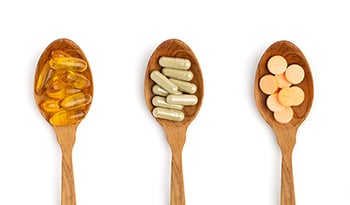有證據幫助的十大營養補充劑
免責聲明:本部落格不提供診斷⋯

在種類繁多的膳食補充劑中,如何將真正優效、安心的補充劑與誇大其詞的補充劑區分開來是一項挑戰。面對優化健康、延壽的承諾,要如何辨別哪些營養補充劑有科學依據,哪些僅僅是時髦的流行趨勢?我們將在本文中討論那些有強有力科學證據幫助的營養補充劑。
肌酸
肌酸是一種由氨基酸L-精氨酸、甘氨酸和L-蛋氨酸組成的化合物。它在能量代謝、肌肉表現和修復中起着至關重要的作用。肌酸還可用於在訓練中提高高強度運動能力並增加瘦體重(而不是脂肪)。人們一開始對肌酸安心性的擔憂已被推翻。研究發現,肌酸不會導致脫發或尿酸水平升高,不會對健康人的腎臟造成損害,也不會引起脫水或肌肉痙攣。
新的證據表明,補充肌酸能增加肌肉和大腦的肌酸儲存。這在壓力時期(例如睡眠中斷和衰老時期)尤其重要,因爲壓力會導致大腦肌酸水平降低。2022年的一項薈萃分析(一項綜合多項研究結果的研究)顯示,補充肌酸可提高健康人的記憶力,尤其是老年人(66至76歲)。
肌酸的服用劑量通常爲每天5毫克一水肌酸。粉末狀肌酸在冷水和室溫水中的溶解度較低,因此需要與溫水混合。
蛋白質粉
肌肉力量越強,各種原因導致的死亡率就越低,因此,在年輕時特大限度地加強肌肉力量,在中年時保持肌肉力量,在老年時盡量減少肌肉流失,這一點非常重要。營養和運動訓練可以減緩或逆轉肌肉衰弱、功能障礙和殘疾,因此醫級指南建議我們增加蛋白質的攝入量。
一些研究報告稱,低蛋白飲食的小鼠壽命更長,因此有一些人建議採用低蛋白飲食來延壽。然而,這種說法並沒有在人類身上得到證實。我們需要保持肌肉力量,以便在衰老過程中保持獨立性和抵御疾病的能力。此外,2020年的一項研究報告顯示,總蛋白質攝入量越高,全因死亡率越低,從而幫助了科學研究推薦的每天每公斤體重攝入1.6-2.2克膳食蛋白質能給人體帶來益處。需要注意的是,攝入量高於每天每公斤體重1.62克的時候,蛋白質不會進一步促進阻力訓練引起的肌肉質量增加。老年人的蛋白質攝入量應達到每天每公斤體重2克(即體重80公斤的人攝入160克蛋白質)。較高的蛋白質攝入量可幫助老年人彌補肌肉的損失,而且他們的消化道對蛋白質的吸收不如年輕人。
國際運動營養學會建議,一天中應進食多餐蛋白質,每餐間隔3-4小時。蛋白質粉中的蛋白質生物利用率很高,而且蛋白質粉極好不要添加鹽和糖,可以將其混合進冰沙和奶昔中服用。
三甲基甘氨酸(TMG或甜菜鹼)
TMG有助於加速三磷酸腺苷(ATP,細胞的能量貨幣)的循環。這樣可以促進肌肉蛋白質的合成,並通過在高強度活動中避免疲勞來提高運動表現。
在2017年的一項系統性綜述表示,TMG補充劑只有在與運動訓練相結合時才能增加力量和爆發力。事實上,TMG在與高強度力量/爆發力運動結合時可能極其優效,因此TMG可能在高代謝需求的訓練環境中發揮上佳效果。例如,TMG可提高專業青少年足球運動員的特大氧排量(有氧體能)和重復衝刺能力。相比之下,無論是否補充肌酸,補充TMG都不會影響未經訓練的個體的力量和爆發力表現。
同型半胱氨酸是一種氨基酸,當其在血液中的含量升高時,罹患阿爾茨海默病的風險會增加。因此,降低血液中的高同型半胱氨酸水平是極有希望幫助預防阿爾茨海默病的乾預措施之一。TMG可能降低血液中的同型半胱氨酸水平。關於TMG對癡呆症發病率的影響,還需要進行更多的研究,但鑑於目前對其益處的了解,TMG的劑量通常爲每天500毫克至1克。
維生素和礦物質
一項研究報告顯示,31% 的美國人面臨至少一種維生素缺乏或貧血的風險。人們通常很難僅靠飲食來達到建議的每日微量營養素攝入量,尤其是維生素B3、維生素D3、維生素K2、鋅和鎂。極近的一項大型研究顯示,連續三年每天補充多種維生素和礦物質可能優化老年人的整體認知能力。大多數多種維生素補充劑都大大超出了建議的每日攝入量,但在選擇多種維生素或礦物質補充劑時,應選擇避免“超大劑量”的補充劑,其配方應能補充健康飲食。
Omega-3
Omega-3脂肪酸主要有三種:α-亞麻酸(ALA)、二十二碳六烯酸(DHA)和二十碳五烯酸(EPA)。ALA是一種必需脂肪酸(人體無法制造),因此必須從食物和飲品中獲取。人體會將少量的ALA轉化爲EPA和DHA,但從食物或膳食補充劑中獲取這兩種海洋歐米伽-3 脂肪酸是提高它們在體內含量的僅有方法。EPA和DHA存在於魚油、磷蝦油、魚肝油和含有藻油的素食產品中。
研究一致表明,與不吃魚的人相比,經常吃魚的人認知能力下降的情況明顯減少。這些發現催生了一種假設,即Omega-3海洋油補充劑可以緩解認知能力下降,但目前這種假說還缺乏隨機對照試驗的證據幫助。例如,對於認知能力健康的老年人、患有老年性黃斑變性眼疾的老年人,甚至輕度/中度阿爾茨海默病患者來說,每天補充Omega-3並不能優化他們的認知能力。這些發現與多項薈萃分析結果一致,即與安慰劑相比,補充Omega-3不會影響健康老年人或阿爾茨海默病患者的認知功能。
補充Omega-3的好處可能僅針對那些不經常在飲食中食用高脂肪魚類的人。在一項對25000多人進行的研究中,每天補充1克Omega-3有將心臟病發作的風險降低28%。梅奧診所的一項薈萃分析也幫助這一結論,該分析表明,補充Omega-3可顯著降低心臟病發作的風險。美國心臟協會認爲,配方高劑量(每天4克)Omega-3脂肪酸可優效、安心地幫助降低甘油三酯水平。
影響Omega-3補充劑效果的因素包括DHA和EPA的劑量、EPA與DHA的比例、EPA和DHA的基線狀態、方方劑使用、健康狀況以及其他營養素的攝入量。Omega-3補充劑通常以乙醚膠囊或瓶裝液體的形式出現,它們的化學形式是甘油三酯或乙酯。當補充劑與含有其他脂肪的膳食一起服用時,當服用甘油三酯形式而不是乙酯形式時,以及當它沒有“腸溶衣”時,油的吸收程度會增加。通常可以每天服用1-2粒膠囊或5毫升液體的Omega-3補充劑。
洋車前子殼
洋車前子殼對我們的腸道細菌非常重要,它是可溶性纖維的主要來源。洋車前子殼可能有助於調節血糖水平,軟化和增加糞便體積,增加飽腹感,並有助於輕體。纖維攝入量越高,總膽固醇和低密度脂蛋白(LDL)膽固醇就越低。此外,洋車前子殼可能對控制血壓高也很優效。與洋車前子殼補充劑有關的一個安心問題是鉛污染,因爲接觸這種重金屬會對肝臟、腎臟、神經系統和心血管系統產生不利影響。因此,選擇經過第三方全度和重金屬含量檢測的品牌至關重要。
洋車前子殼補充劑通常以粉末或膠囊的形式存在。洋車前子殼粉可以混合入冰沙或奶昔中。比較好的做法是從低劑量開始(如半茶匙殼粉),逐漸增加劑量至每天1-2茶匙(5-10克)。要確保在服用洋車前子補充劑時搭配大量液體(極好是水),這一點很重要。
膠原蛋白
膠原蛋白是我們身體中含量尤爲豐富的一種蛋白質。氨基酸是蛋白質的組成成分,而膠原蛋白肽是氨基酸的短鏈。因此,關於膠原蛋白肽補充劑是否能在足夠的蛋白質攝入量之外帶來額外的益處,還存在很多爭議。一項隨機、雙盲、安慰劑對照試驗顯示,膠原蛋白補充劑可消減約8%的皺紋。
在2020年的一項隨機雙盲醫級試驗中,比較了36克水解牛膠原蛋白和35克大豆蛋白對男性燒傷患者傷口愈合的影響,與大豆蛋白相比,使用補充水解膠原蛋白後傷口愈合率明顯提高。(大豆蛋白的生物利用率高,對男性體內的動情素或睾酮水平沒有影響,因此大豆蛋白是一個很好的比較對象)。此外,2023年的一項薈萃分析發現,有充分證據表明水解膠原蛋白能優化皮膚的水合作用和彈性。
除了滿足日常蛋白質攝入目標外,膠原蛋白肽補充劑的劑量通常爲每天10-15克。
透明質酸(玻尿酸)
透明質酸是一種天然存在於人體中的物質,它在皮膚、關節和眼睛中含量較高。透明質酸具有獨特的保水功能,有助於保持組織溼潤和潤滑。雖然人體50%的透明質酸存在於皮膚中,但隨着年齡的增長,皮膚中透明質酸的含量會逐漸減少。幾項精心設計的人體試驗表明,口服透明質酸補充劑可優化皮膚的水合作用、色澤、厚度、彈性、緊雅度、光澤和柔軟度,同時減少皮膚皺紋,防止皮膚脫水。
有人擔心透明質酸與惡性細胞變異有關,但給已經患癌的小鼠服用透明質酸後,並沒有產生有害影響。持續至少12個月的人體試驗也顯示沒有安心問題。
當我們攝入高分子量的口服透明質酸時,腸道細菌會將其分解成較短的低分子量片段。盡管透明質酸的生物利用度因分子量而異,但高分子量和低分子量的透明質酸都能控制皮膚皺紋,優化皮膚光澤和柔軟。雖然還需要更多的研究,但目前的文獻表明,營養補充劑中透明質酸的分子量不太可能對其功效產生影響。人體試驗中透明質酸的劑量範圍爲每天80毫克至200毫克。
低劑量褪黑素
褪黑素是由大腦中的鬆果體分泌的一種荷爾蒙。 當天黑時,鬆果體開始分泌褪黑素,而光線則使其停止分泌。褪黑素有助於控制人體的晝夜節律,讓我們晚上困倦,白天清醒。這使我們能夠入睡,並獲得良好的夜間休息。研究顯示,褪黑素可以幫助人們更快入睡,並提高睡眠質量,但對於服用多少褪黑素以及何時服用尚存疑慮。
作爲一種“時間生物劑”,褪黑素可以改變我們的睡眠-覺醒周期。目前的研究幫助在入睡前1-2小時服用褪黑素補充劑,以獲得上佳效果。相比之下,在夜間人體褪黑素水平已經很高時服用褪黑素補充劑則沒有任何效果。我們的身體每晚會制造10-80微克的褪黑素,但服用褪黑素補充劑的人通常服用的劑量要比這高得多。不過,還需要更多的研究來確定高劑量服用的長期效果,因此建議每天服用褪黑素的劑量極好不要超過300微克。此外,在這個領域的研究還在活躍地進行中,目前還沒有強有力的證據表明補充褪黑素會降低死亡率或減少心臟病。
關於衰老需要考慮的一個重要方面是,褪黑素除了對睡眠有影響外,還具有抗氧和緩解炎性反應作用。隨着年齡的增長,體內褪黑素的分泌量會減少10倍,而褪黑素分泌量的減少會加劇衰老過程。這可能會形成一個惡性循環——隨着年齡的增長,褪黑素減少,炎性反應加劇,從而進一步減少人體產生的褪黑素分泌量。因此,爲了使褪黑素水平修復到更年輕的狀態,老年人應考慮在入睡前1-2小時服用低劑量、長效緩釋型褪黑素補充劑。
N-乙酰半胱氨酸(NAC)
NAC是一種衍生自氨基酸L-半胱氨酸的化合物。隨着年齡的增長,爲了維持生存,活性氧類(氧化劑)會增加。但是,它們終究會累積起來,並加重而不是減輕與年齡有關的損傷。保持氧化劑和抗氧劑之間的平衡非常重要,但從我們邁入45歲開始,一種名爲谷胱甘肽的優效抗氧劑就迅速減少。因此,建議通過補充谷胱甘肽的組成成分來修復氧化劑和抗氧劑之間的平衡。谷胱甘肽的組成成分包括甘氨酸、半胱氨酸和谷氨酸。
與此列表中的其他補充劑不同,NAC研究仍處於早期階段。不過,2022年的一項隨機、雙盲、安慰劑對照試驗顯示,老年人補充甘氨酸和NAC(GlyNAC)可能讓谷胱甘肽缺乏症好轉,減少氧化應激,優化線粒體功能障礙。鑑於膠原蛋白和TMG補充劑(前文已述)含有甘氨酸,服用膠原蛋白或甘氨酸的人可以考慮從45歲開始每天只添加1克NAC。
結語
補充劑可能可以彌補特定營養素的不足,解決特定的健康問題,或以某種方式優化身體結構/功能。不過,建議在使用營養補充劑之前,盡量從高質量的膳食中攝取營養。此外,使用補充劑必須謹慎,確保其對人體安心。
根據你的健康狀況、目前的方方劑和健康目標,諮詢合適的醫級健康專業人員可以幫助你確定適合你個人需求的補充劑。上述營養補充劑顯示出了良好的應用前景,但在大多數情況下,我們還需要更多的隨機對照試驗來確定它們所有的益處、上佳劑量、上佳服用時間和禁忌症。
參考資料:
- Kreider RB, Kalman DS, Antonio J, Ziegenfuss TN, Wildman R, Collins R, et al. International Society of Sports Nutrition position stand: safety and efficacy of creatine supplementation in exercise, sport, and medicine. Journal of the International Society of Sports Nutrition. 2017 Jan 3;14(1):18.
- De Moraes R, Van Bavel D, De Moraes BS, Tibiriçá E. Effects of dietary creatine supplementation on systemic microvascular density and reactivity in healthy young adults. Nutr J. 2014 Dec;13(1):115.
- Forbes SC, Cordingley DM, Cornish SM, Gualano B, Roschel H, Ostojic SM, et al. Effects of Creatine Supplementation on Brain Function and Health. Nutrients. 2022 Feb 22;14(5):921.
- Antonio J, Candow DG, Forbes SC, Gualano B, Jagim AR, Kreider RB, et al. Common questions and misconceptions about creatine supplementation: what does the scientific evidence really show? Journal of the International Society of Sports Nutrition. 2021 Jan 2;18(1):13.
- Cruz-Jentoft AJ, Bahat G, Bauer J, Boirie Y, Bruyère O, Cederholm T, et al. Sarcopenia: revised European consensus on definition and diagnosis. Age and Ageing. 2019 Jan 1;48(1):16–31.
- Bloom I, Shand C, Cooper C, Robinson S, Baird J. Diet Quality and Sarcopenia in Older Adults: A Systematic Review. Nutrients. 2018 Mar 5;10(3):308.
- Solon-Biet SM, McMahon AC, Ballard JWO, Ruohonen K, Wu LE, Cogger VC, et al. The Ratio of Macronutrients, Not Caloric Intake, Dictates Cardiometabolic Health, Aging, and Longevity in Ad Libitum-Fed Mice. Cell Metabolism. 2014 Mar;19(3):418–30.
- Naghshi S, Sadeghi O, Willett WC, Esmaillzadeh A. Dietary intake of total, animal, and plant proteins and risk of all cause, cardiovascular, and cancer mortality: systematic review and dose-response meta-analysis of prospective cohort studies. BMJ. 2020 Jul 22;m2412.
- Morton RW, Murphy KT, McKellar SR, Schoenfeld BJ, Henselmans M, Helms E, et al. A systematic review, meta-analysis and meta-regression of the effect of protein supplementation on resistance training-induced gains in muscle mass and strength in healthy adults. Br J Sports Med. 2018 Mar;52(6):376–84.
- Jäger R, Kerksick CM, Campbell BI, Cribb PJ, Wells SD, Skwiat TM, et al. International Society of Sports Nutrition Position Stand: protein and exercise. Journal of the International Society of Sports Nutrition. 2017 Jan 3;14(1):20.
- Baraki, Austin, Feigenbaum, Jordan, Sullivan, Jonathon. Practical guidelines for implementing a strength training program for adults [Internet]. Wolters Kluwer; 2023. Available from: https://www.uptodate.com/contents/practical-guidelines-for-implementing-a-strength-training-program-for-adults
- Volaklis KA, Halle M, Meisinger C. Muscular strength as a strong predictor of mortality: A narrative review. European Journal of Internal Medicine. 2015 Jun;26(5):303–10.
- Sargeant AJ. Structural and functional determinants of human muscle power. Experimental Physiology. 2007 Mar;92(2):323–31.
- Ismaeel A. Effects of Betaine Supplementation on Muscle Strength and Power: A Systematic Review. Journal of Strength and Conditioning Research. 2017 Aug;31(8):2338–46.
- Lee EC, Maresh CM, Kraemer WJ, Yamamoto LM, Hatfield DL, Bailey BL, et al. Ergogenic effects of betaine supplementation on strength and power performance. Journal of the International Society of Sports Nutrition. 2010 Jan 5;7(1):27.
- Nobari H, Cholewa JM, Castillo-Rodríguez A, Kargarfard M, Pérez-Gómez J. Effects of chronic betaine supplementation on performance in professional young soccer players during a competitive season: a double blind, randomized, placebo-controlled trial. Journal of the International Society of Sports Nutrition. 2021 Jan 2;18(1):67.
- Del Favero S, Roschel H, Artioli G, Ugrinowitsch C, Tricoli V, Costa A, et al. Creatine but not betaine supplementation increases muscle phosphorylcreatine content and strength performance. Amino Acids. 2012 Jun;42(6):2299–305.
- Yu JT, Xu W, Tan CC, Andrieu S, Suckling J, Evangelou E, et al. Evidence-based prevention of Alzheimer's disease: systematic review and meta-analysis of 243 observational prospective studies and 153 randomised controlled trials. J Neurol Neurosurg Psychiatry. 2020 Nov;91(11):1201–9.
- Bird J, Murphy R, Ciappio E, McBurney M. Risk of Deficiency in Multiple Concurrent Micronutrients in Children and Adults in the United States. Nutrients. 2017 Jun 24;9(7):655.
- Baker LD, Manson JE, Rapp SR, Sesso HD, Gaussoin SA, Shumaker SA, et al. Effects of cocoa extract and a multivitamin on cognitive function: A randomized clinical trial. Alzheimer's & Dementia. 2023 Apr;19(4):1308–19.
- Singh P, Gollapalli K, Mangiola S, Schranner D, Yusuf MA, Chamoli M, et al. Taurine deficiency as a driver of aging. Science. 2023 Jun 9;380(6649):eabn9257.
- Van Gelder BM, Tijhuis M, Kalmijn S, Kromhout D. Fish consumption, n−3 fatty acids, and subsequent 5-y cognitive decline in elderly men: the Zutphen Elderly Study. The American Journal of Clinical Nutrition. 2007 Apr;85(4):1142–7.
- Dangour AD, Allen E, Elbourne D, Fasey N, Fletcher AE, Hardy P, et al. Effect of 2-y n−3 long-chain polyunsaturated fatty acid supplementation on cognitive function in older people: a randomized, double-blind, controlled trial. The American Journal of Clinical Nutrition. 2010 Jun;91(6):1725–32.
- Chew EY, Clemons TE, Agrón E, Launer LJ, Grodstein F, Bernstein PS. Effect of Omega-3 Fatty Acids, Lutein/Zeaxanthin, or Other Nutrient Supplementation on Cognitive Function: The AREDS2 Randomized Clinical Trial. JAMA. 2015 Aug 25;314(8):791.
- Freund-Levi Y, Eriksdotter-Jönhagen M, Cederholm T, Basun H, Faxén-Irving G, Garlind A, et al. ω-3 Fatty Acid Treatment in 174 Patients With Mild to Moderate Alzheimer Disease: OmegAD Study: A Randomized Double-blind Trial. Arch Neurol. 2006 Oct 1;63(10):1402.
- Jiao J, Li Q, Chu J, Zeng W, Yang M, Zhu S. Effect of n−3 PUFA supplementation on cognitive function throughout the life span from infancy to old age: a systematic review and meta-analysis of randomized controlled trials. The American Journal of Clinical Nutrition. 2014 Dec;100(6):1422–36.
- Manson JE, Cook NR, Lee IM, Christen W, Bassuk SS, Mora S, et al. Marine n−3 Fatty Acids and Prevention of Cardiovascular Disease and Cancer. N Engl J Med. 2019 Jan 3;380(1):23–32.
- Bernasconi AA, Wiest MM, Lavie CJ, Milani RV, Laukkanen JA. Effect of Omega-3 Dosage on Cardiovascular Outcomes. Mayo Clinic Proceedings. 2021 Feb;96(2):304–13.
- Skulas-Ray AC, Wilson PWF, Harris WS, Brinton EA, Kris-Etherton PM, Richter CK, et al. Omega-3 Fatty Acids for the Management of Hypertriglyceridemia: A Science Advisory From the American Heart Association. Circulation [Internet]. 2019 Sep 17 [cited 2024 Mar 2];140(12). Available from: https://www.ahajournals.org/doi/10.1161/CIR.0000000000000709
- Office of Dietary Supplements - Omega-3 Fatty Acids [Internet]. [cited 2024 Mar 3]. Available from: https://ods.od.nih.gov/factsheets/Omega3FattyAcids-Consumer/
- Troesch B, Eggersdorfer M, Laviano A, Rolland Y, Smith AD, Warnke I, et al. Expert Opinion on Benefits of Long-Chain Omega-3 Fatty Acids (DHA and EPA) in Aging and Clinical Nutrition. Nutrients. 2020 Aug 24;12(9):2555.
- Hartley L, May MD, Loveman E, Colquitt JL, Rees K. Dietary fibre for the primary prevention of cardiovascular disease. Cochrane Heart Group, editor. Cochrane Database of Systematic Reviews [Internet]. 2016 Jan 7 [cited 2024 Feb 28];2016(2). Available from: http://doi.wiley.com/10.1002/14651858.CD011472.pub2
- Brum JM, Gibb RD, Peters JC, Mattes RD. Satiety effects of psyllium in healthy volunteers. Appetite. 2016 Oct;105:27–36.
- Lambeau KV, McRorie JW. Fiber supplements and clinically proven health benefits: How to recognize and recommend an effective fiber therapy. Journal of the American Association of Nurse Practitioners. 2017 Apr;29(4):216–23.
- Clark CCT, Salek M, Aghabagheri E, Jafarnejad S. The effect of psyllium supplementation on blood pressure: a systematic review and meta-analysis of randomized controlled trials. Korean J Intern Med. 2020 Nov 1;35(6):1385–99.
- Kumar A, Kumar A, M.M.S. CP, Chaturvedi AK, Shabnam AA, Subrahmanyam G, et al. Lead Toxicity: Health Hazards, Influence on Food Chain, and Sustainable Remediation Approaches. IJERPH. 2020 Mar 25;17(7):2179.
- Kim J, Lee SG, Lee J, Choi S, Suk J, Lee JH, et al. Oral Supplementation of Low-Molecular-Weight Collagen Peptides Reduces Skin Wrinkles and Improves Biophysical Properties of Skin: A Randomized, Double-Blinded, Placebo-Controlled Study. Journal of Medicinal Food. 2022 Dec 1;25(12):1146–54.
- Bagheri Miyab K, Alipoor E, Vaghardoost R, Saberi Isfeedvajani M, Yaseri M, Djafarian K, et al. The effect of a hydrolyzed collagen-based supplement on wound healing in patients with burn: A randomized double-blind pilot clinical trial. Burns. 2020 Feb;46(1):156–63.
- Reed KE, Camargo J, Hamilton-Reeves J, Kurzer M, Messina M. Neither soy nor isoflavone intake affects male reproductive hormones: An expanded and updated meta-analysis of clinical studies. Reproductive Toxicology. 2021 Mar;100:60–7.
- Pu SY, Huang YL, Pu CM, Kang YN, Hoang KD, Chen KH, et al. Effects of Oral Collagen for Skin Anti-Aging: A Systematic Review and Meta-Analysis. Nutrients. 2023 Apr 26;15(9):2080.
- Gao Y, Wang R, Zhang L, Fan Y, Luan J, Liu Z, et al. Oral administration of hyaluronic acid to improve skin conditions via a randomized double‐blind clinical test. Skin Research and Technology. 2023 Nov;29(11):e13531.
- Hsu TF, Su ZR, Hsieh YH, Wang MF, Oe M, Matsuoka R, et al. Oral Hyaluronan Relieves Wrinkles and Improves Dry Skin: A 12-Week Double-Blinded, Placebo-Controlled Study. Nutrients. 2021 Jun 28;13(7):2220.
- Laurent TC, Fraser JR. Hyaluronan. FASEB J. 1992 Apr;6(7):2397–404.
- Oe M, Sakai S, Yoshida H, Okado N, Kaneda H, Masuda Y, et al. Oral hyaluronan relieves wrinkles: a double-blinded, placebo-controlled study over a 12-week period. CCID. 2017 Jul;Volume 10:267–73.
- Michelotti A, Cestone E, De Ponti I, Pisati M, Sparta E, Tursi F. Oral intake of a new full-spectrum hyaluronan improves skin profilometry and ageing: a randomized, double-blind, placebo-controlled clinical trial. European Journal of Dermatology. 2021 Dec;31(6):798–805.
- Seino S, Takeshita F, Asari A, Masuda Y, Kunou M, Ochiya T. No Influence of Exogenous Hyaluronan on the Behavior of Human Cancer Cells or Endothelial Cell Capillary Formation. Journal of Food Science [Internet]. 2014 Jul [cited 2024 Feb 28];79(7). Available from: https://ift.onlinelibrary.wiley.com/doi/10.1111/1750-3841.12500
- Oe M, Mitsugi K, Odanaka W, Yoshida H, Matsuoka R, Seino S, et al. Dietary Hyaluronic Acid Migrates into the Skin of Rats. The Scientific World Journal. 2014;2014:1–8.
- Cyphert JM, Trempus CS, Garantziotis S. Size Matters: Molecular Weight Specificity of Hyaluronan Effects in Cell Biology. International Journal of Cell Biology. 2015;2015:1–8.
- Tashiro T, Seino S, Sato T, Matsuoka R, Masuda Y, Fukui N. Oral Administration of Polymer Hyaluronic Acid Alleviates Symptoms of Knee Osteoarthritis: A Double-Blind, Placebo-Controlled Study over a 12-Month Period. The Scientific World Journal. 2012;2012:1–8.
- Seithikurippu R AM. Melatonin, the Hormone of Darkness: From Sleep Promotion to Ebola Treatment. Brain Disord Ther [Internet]. 2015 [cited 2024 Feb 28];04(01). Available from: http://www.omicsgroup.org/journals/melatonin-the-hormone-of-darkness-from-sleep-promotion-to-ebola-treatment-2168-975X.1000151.php?aid=36189
- Low TL, Choo FN, Tan SM. The efficacy of melatonin and melatonin agonists in insomnia – An umbrella review. Journal of Psychiatric Research. 2020 Feb;121:10–23.
- Fatemeh G, Sajjad M, Niloufar R, Neda S, Leila S, Khadijeh M. Effect of melatonin supplementation on sleep quality: a systematic review and meta-analysis of randomized controlled trials. J Neurol. 2022 Jan;269(1):205–16.
- Peuhkuri K, Sihvola N, Korpela R. Dietary factors and fluctuating levels of melatonin. Food & Nutrition Research. 2012 Jan;56(1):17252.
- Hardeland R. Aging, Melatonin, and the Pro- and Anti-Inflammatory Networks. IJMS. 2019 Mar 11;20(5):1223.
- Melhuish Beaupre LM, Brown GM, Gonçalves VF, Kennedy JL. Melatonin's neuroprotective role in mitochondria and its potential as a biomarker in aging, cognition and psychiatric disorders. Transl Psychiatry. 2021 Jun 2;11(1):339.
- Hekimi S, Lapointe J, Wen Y. Taking a "good" look at free radicals in the aging process. Trends in Cell Biology. 2011 Oct;21(10):569–76.
- Richie JP, Nichenametla S, Neidig W, Calcagnotto A, Haley JS, Schell TD, et al. Randomized controlled trial of oral glutathione supplementation on body stores of glutathione. Eur J Nutr. 2015 Mar;54(2):251–63.
- Jones DP, Mody VC, Carlson JL, Lynn MJ, Sternberg P. Redox analysis of human plasma allows separation of pro-oxidant events of aging from decline in antioxidant defenses. Free Radical Biology and Medicine. 2002 Nov;33(9):1290–300.
- Kumar P, Liu C, Suliburk J, Hsu JW, Muthupillai R, Jahoor F, et al. Supplementing Glycine and N-Acetylcysteine (GlyNAC) in Older Adults Improves Glutathione Deficiency, Oxidative Stress, Mitochondrial Dysfunction, Inflammation, Physical Function, and Aging Hallmarks: A Randomized Clinical Trial. Lipsitz LA, editor. The Journals of Gerontology: Series A. 2023 Jan 26;78(1):75–89.

 作者 Brad Stanfield 博士,M.D.
作者 Brad Stanfield 博士,M.D. 


